Czech Food – 25 Traditional Czech Dishes You Have to Try
Unlike other European cuisines, few people are aware of what traditional Czech food looks like.
Although many people visit the capital of Prague to enjoy the cheap beer and crazy nightlife, few visitors to the Czech Republic* do so with the aim of indulging in all the best Czech dishes, and I’m sure that many Prague partygoers end up sustaining themselves on a drunk diet of kebabs and McDonald’s, without even munching a single Nutella-smothered trdelnik!
However, if you’re reading this article then chances are you’re not one of those people, and you’re wondering what traditional Czech food is like.
So, without further ado, here are all the best Czech foods that you absolutely have to try.
Traditional Czech food in a nutshell
With culinary influences from Germany, Hungary, East Europe and even Balkan food, Czech cuisine is a rich mix of flavours.
At its heart, Czech food is comfort food, with a focus on succulent meats, rich sauces, root vegetables and potatoes.
It is especially rewarding to visit the Czech Republic in the winter time, where you will be able to make the most of the dense, hearty soups, meat stews and stodgy dumplings that feel like a hug from the inside out.
A typical meal in the Czech Republic will consist of two courses – usually a soup followed by a meat dish, and perhaps a slice of cake for dessert.
It almost goes without saying that both lunch and dinner are accompanied by a beer – in fact, most Czech restaurants will have an entire section on their menu dedicated to ‘beer food!’
In fact, the Czech Republic consumes the most beer per-capita than any other country in the world – Na zdraví!
In order to make sure that you don’t miss out, I’ve compiled a list of traditional Czech food that you can’t miss on your trip to Prague.
Here are my favourite classic Czech dishes.
Traditional Czech Food – 25 Mouthwatering Czech Dishes You Have to Try
1. Knedliky
Starting off simple, we have a type of bread which is called knedliky.
Knedliky is a kind of Czech dumpling perfect for mopping up all of those thick sauces that the Czech cuisine is packed full of – in fact, most soups, stews and sauce-based dishes in the Czech Republic will be served with a side of Czech dumplings.
Knedliky are made by rolling dough into small dumplings, and then boiling or steaming them. They can be sweet or savoury.
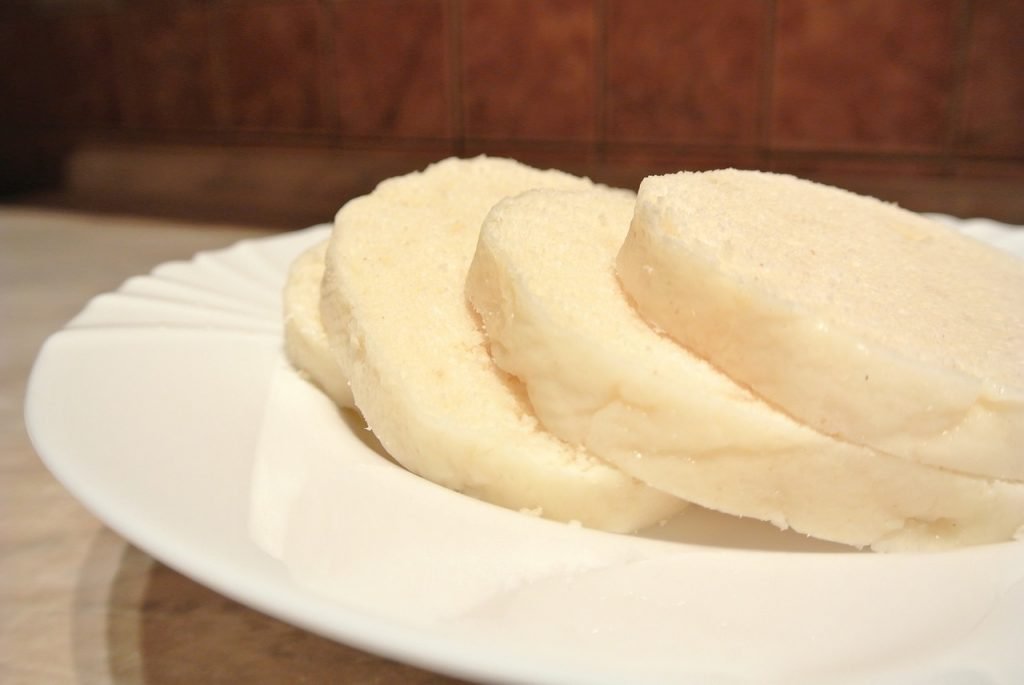
2. Svíčková na smetaně
I first tried Svíčková na smetaně in an old Bohemian castle (yes, you can be jealous!) and when I first saw the plate coming over to me, I was a little nervous.
Svíčková na smetaně is the name given to slices of beef covered in a sweet vegetable puree (made from carrot, parsley and celery) with a dollop of whipped cream on top, a generous helping of cranberry sauce and slices of lemon, along with some sweet knedliky Czech dumplings to top it off.
It might sound like a strange combination, but svíčková na smetaně is known as one of the best Czech dishes out there, and with a preparation time of over 3 hours, it is usually only prepared for special occasions.
To be perfectly honest, svíčková na smetaně wasn’t for me.
I’m not a lover of mixing sweet and savoury at the best of times, and the mixture of meat with whipped cream and cranberries was just too much for me.
With that said, svíčková na smetaně is one of the most famous Czech foods foods there is, and so you should definitely try it for yourself and see how you feel!
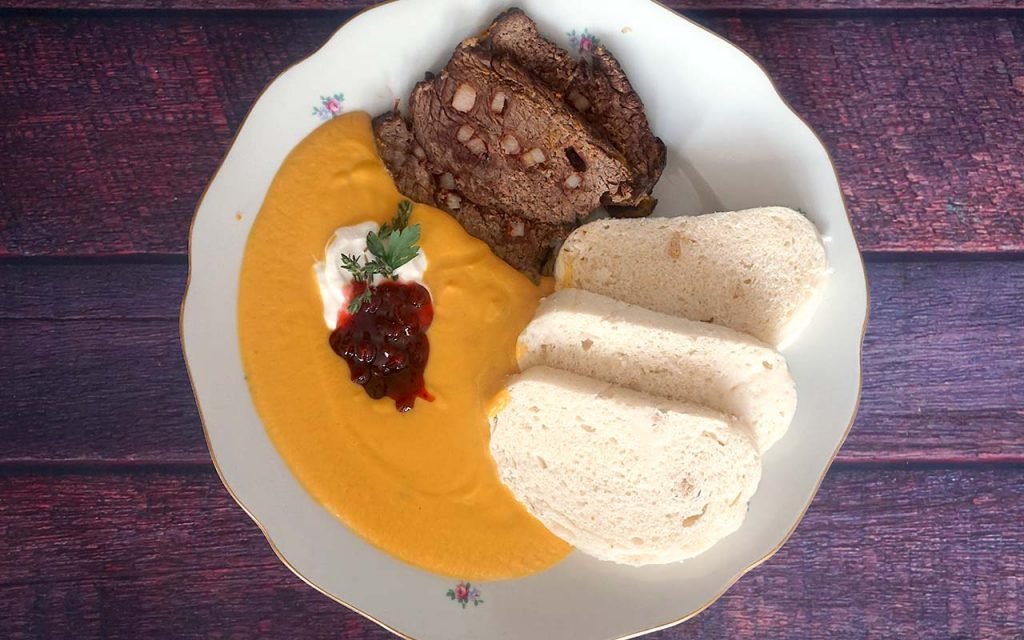
3. Tatarák
Although not exclusively a traditional Czech food, tatarák, or beef tartare is a big part of Czech cuisine, and you’ll almost definitely come across it on restaurant menus.
Beef tartare is ground raw beef topped with a raw egg yolk and served alongside chopped onions and pickled cucumber, along with paprika, salt, pepper and mustard and a hunk of thick crusty bread.
This is a really special Czech food, as not only do the strong flavours create an explosion on the palette, but the marrying of textures, particularly that of the raw beef with the egg yolk, come together to create a unique and tasty dish.
The best way to eat tatarák is to pour the egg yolk into the middle of the raw beef and then mash everything up together – I tend to use the bread to mop up the remains but some people prefer to spread the tartare right onto the bread.

4. Trdelník
Trdelník, which means ‘chimney cake’ are a bit of a mystery, with most people believing that they originate from Transylvania in Romania, with some people arguing they come from Slovakia and others believing they are a Czech food.
Regardless of which camp you’re in, you will find Trdelník on every street corner in Prague and if you have a sweet tooth, you have got to try one.
Trdelník are made by wrapping dough around a stick and sprinkling it with sugar and cinnamon before roasting it over an open flame.
They can be served alone or with treats such as Nutella or ice cream.
A trdelník from a street food vendor in Prague will usually cost around 2 EUR, and they are absolutely massive, so don’t buy one just before lunch!
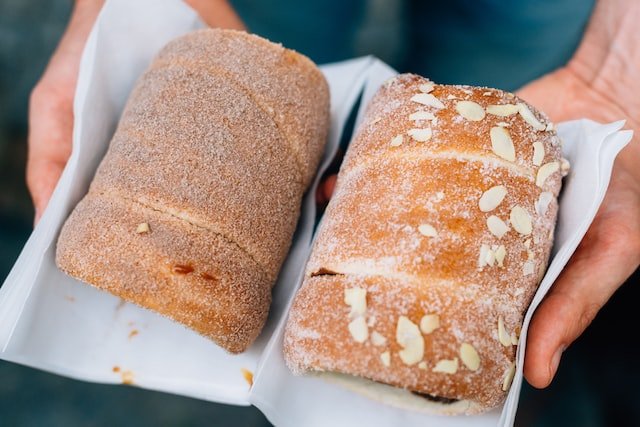
5. Chlebíčky
A chlebíčky is an open-faced sandwich and a typical Czech breakfast food.
Almost all of the hotels I’ve stayed in in the Czech Republic have laid out the ingredients to make a chlebíčky as part of their breakfast buffet and chlebíčky are also a common sight in deli shops around Prague.
Common toppings include ham, cheese, tomato, cucumber, pickles, salami and egg.
6. Guláš
Guláš, or what you may know as goulash, probably originated in Hungary, but if you’re wondering what to eat in Prague, you simply have to include goulash on your list.
Popular all over Central Europe, goulash is a thick, meaty stew, usually made with chunks of beef (but it can be made with pork or wild boar instead), and seasoned with paprika.
Knedliky dumplings are usually served along with it to mop up the sauce.
You will find goulash absolutely everywhere in Prague as it is one of the most popular Czech foods there is, and no trip to the Czech Republic is complete without at least one helping of goulash.

7. Palačinky
Palačinky, otherwise known as crepes, are not unique additions to Czech cuisine, but nevertheless, they’re still extremely popular.
Usually served as a dessert (but they can be a main dish too), palačinky can be topped with anything including jam, nuts, chocolate sauce, fruit, ice cream and sweet cheese.
Savoury versions can be served with spinach, meat or cheese, which I prefer.

8. Vepřové koleno
Vepřové koleno is pork knuckle (that you may know as a ‘ham hock’), which is a common Polish dish as well!
With extremely tender meat that has been marinated in dark beer, pork knuckle is eaten from the bone for extra flavour, and is usually served with horseradish, mustard and sauerkraut.
Pretty much every traditional Czech restaurant will have vepřové koleno on their menu, and if you’re a meat lover, it’s a must-try.

9. Vepřo knedlo zelo
Vepřo knedlo zelo is one of the most popular Czech dishes there is. It consists of tender roast pork and dumplings, served with sauerkraut or red cabbage and drizzled in onion gravy.
One to fill your belly in the harsh winter months, vepřo knedlo zelo, like most other Czech foods, is always washed down with a glass of cold Pilsner.
10. Kulajda
Kulajda is a delicious creamy potato and mushroom soup, seasoned with vinegar and dill and served with a poached quail’s egg on top.
Of all the Czech soups, this one is one of the heaviest, and while you can eat it as a starter, it is perfectly acceptable to order kulajda as a main meal as well.
11. Bramboráky
Bramboráky are Czech potato pancakes and they are one of the few vegetarian Czech dishes out there!
They can be served as a main, side dish or street food, and are made from grated potatoes, crushed garlic, cumin, flour and eggs, seasoned with salt and pepper and often served with sour cream and chives.
They can also be stuffed with pretty much whatever your heart desires, as I found out in Brno when I ordered bramboráky with smoked pork neck, sauerkraut, beer cheese and garlic sour cream – delicious!
While Czech potato pancakes may not be good for your waistband, it’s difficult to care when they taste as good as they do!

12. Pečená Kachna se Zelím
Another quintessential Czech food is Pečená Kachna se Zelím, or slow-roasted duck with dumplings and braised red cabbage or sauerkraut.
Roast duck is very common in the Czech Republic, and you’ll find duck or goose on most restaurant menus.
I was lucky enough to attend a private cooking show where two chefs prepared Pečená Kachna se Zelím for myself and some fellow bloggers to eat, and it was quite possibly the nicest duck I’ve ever eaten.
The flavours of the sweet red cabbage combined with the richness of the duck, the saltiness of its juices and the garlic and caraway seasonings were simply divine.

(I spent way too long thinking of that)
13. Zelňačka
Zelňačka is a sour cabbage soup made from sauerkraut. It also contains smoked sausage as well as potatoes and sour cream.
Due to the heavy presence of sauerkraut, this Czech soup certainly has an acquired taste, but the smoked meat complements the fermented cabbage perfectly, and it is an intoxicating mix of flavours.
14. Smažený vepřový rízek
Smažený vepřový rízek is one of the most simple Czech foods, and is basically the Czech equivalent of a pork schnitzel (although veal and chicken cutlets are common as well).
While schnitzel (rízek) is obviously not unique to the Czech Republic, it is an integral part of classic Czech cuisine and a common working man’s lunch.
Rízek is served with potatoes, a slice of lemon and fresh parsley.

15. Česnečka
Česnečka is one of my favourite Czech foods and is one of the oldest soups in the Czech Republic.
This soup has a garlic base and is served with croutons (both in the soup and also on the side), as well as a raw egg, which is added near the end to give a denser texture.
Česnečka can also have small pieces of sausage or cheese cubes added in, and it is widely known as a hangover soup, making it perfect after a long night on the Czech beer!
16. Sekaná Pečeně
Sekaná Pečeně is a Czech meatloaf made from baked minced meat (beef or pork, sometimes both) with chopped onions, garlic, bell peppers, parsley and marjoram.
Oftentimes, bacon is added, making the dish even meatier.
Like most Czech foods, meatloaf is a fantastic winter dish, so if you’re wondering what to eat in Prague in the cooler months, you should put sekaná pečeně at the top of your list.
17. Smažák
Another of the few vegetarian Czech foods, smažák is a giant slab of fried cheese, breaded and deliciously greasy.
It can be served either as a bar snack or a main dish (usually served with boiled potatoes, butter and dill), and the cheese used tends to be Edam.
I’m ashamed to say how many of these I indulged in on my trips to the Czech Republic but hey, it’s a brilliant hangover food!

18. Rajská omáčka
Rajská omáčka is a beef dish with tomato sauce, made from pureed tomatoes and tomato paste.
The beef is roasted and sliced before being doused in the sauce and accompanied by Czech dumplings.
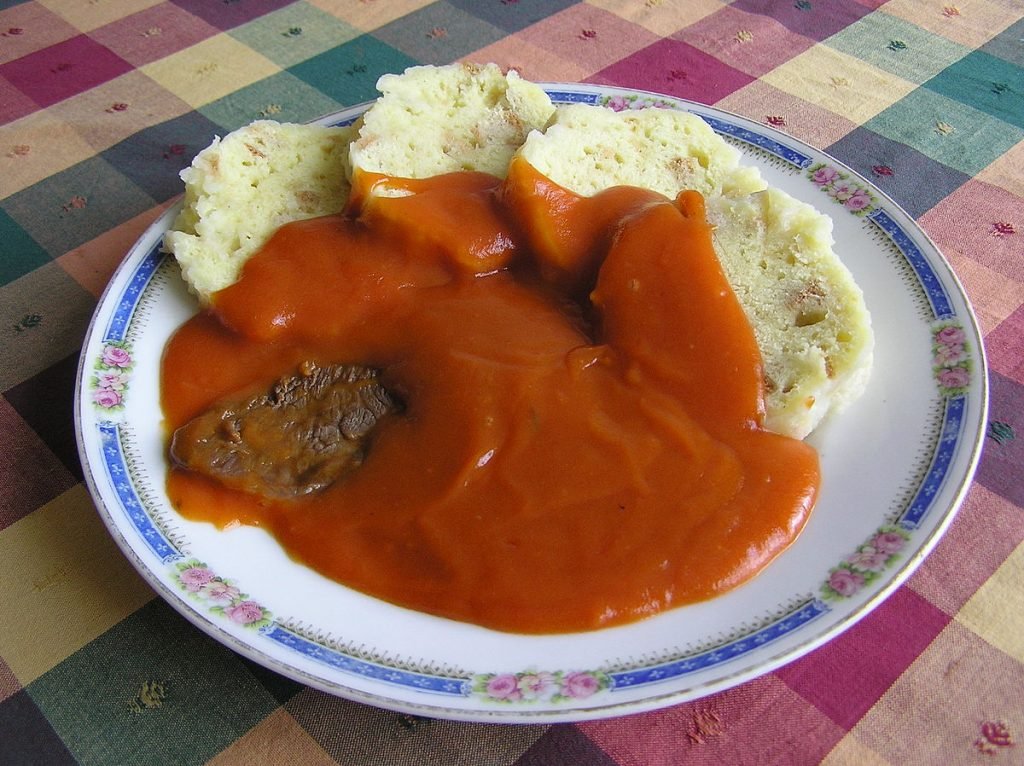
19. Moravský Vrabec
Moravský Vrabec, which means ‘Moravian sparrow’ is another one of the most popular Czech dishes.
A stodgy, heavy dish, Moravský Vrabec has nothing to do with sparrows (or birds at all!).
Rather, it is a pork dish where the meat is taken from the shoulder (or other fatty cuts), chopped into little chunks and served with either red cabbage and bread dumplings, or white cabbage and potato dumplings.
Regardless of the combination you try, you’re guaranteed to be full to burst after a full plate of Moravský Vrabec.
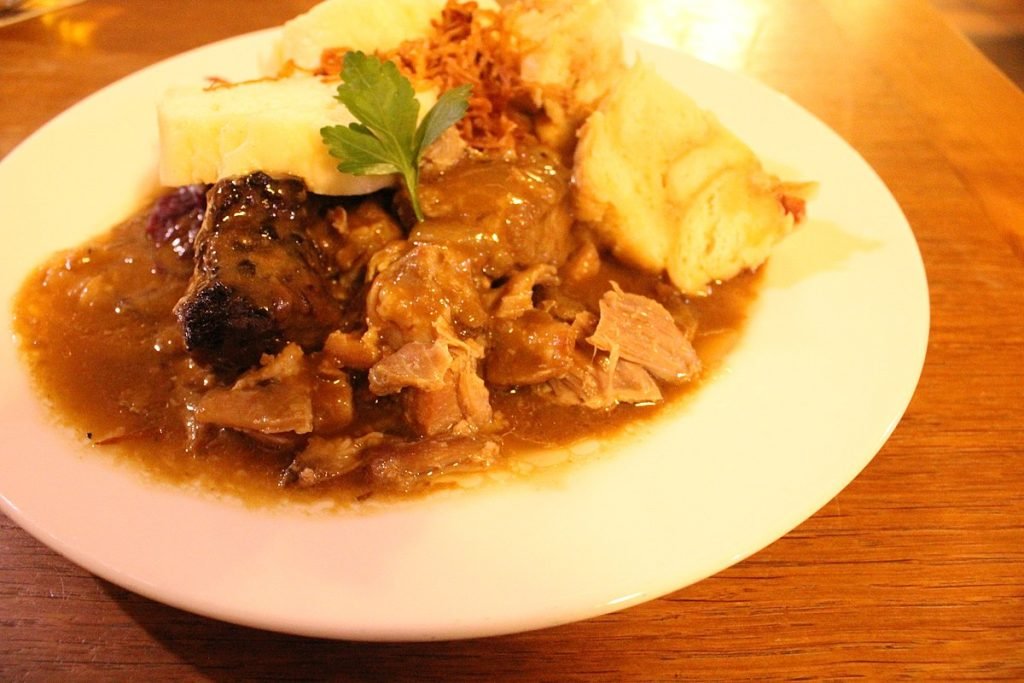
20. Pivo!
In case you didn’t know it, the Czech word for ‘beer’ is PIVO, and despite it technically not being a food, I couldn’t write a post about traditional Czech cuisine and leave off their national pride!
Beer is a way of life in the Czech Republic, as not only do the Czechs drink more of the stuff than anyone else, but it is also the birthplace of Pilsner!
In Prague, not only can you visit a brewery or hire a beer bike, but you can even take a bath in the stuff!
In fact, in the Czech Republic, beer is cheaper than bottled water, and it is not uncommon to see people in the early afternoon or late morning having a beer with their friends.
Seriously – if you go to the right places, you can find pints of beer for as little as 14 koruna (0.54 EUR), whereas a .33cl bottle of water will cost you 35 koruna on average!
While craft beers and ales are slowly beginning to catch on among Czech youth, the most popular types of beer in the Czech Republic are lager and Pilsner.
A beer is always served with a huge frothy head, as this is said to absorb the bubbles from the beer and result in a nicer taste with less bloating.

21. Aspic
While the Czech Republic cannot claim ownership of this – ahem – interesting food, aspic is still wildly popular there, and I was served it on my first day during my most recent trip.
Aspic is a savoury gelatine made from meat stock or broth, with other ingredients inside.
The aspic that I tried was simply made from rolls of ham and red peppers encased in a flavourless gelatine (made without the stock), and I won’t lie to you – it makes me shudder to think about.
With that said, the thought of eating gelatine in general makes me shudder, so if you’re not averse to a little animal jelly, you might enjoy aspic.
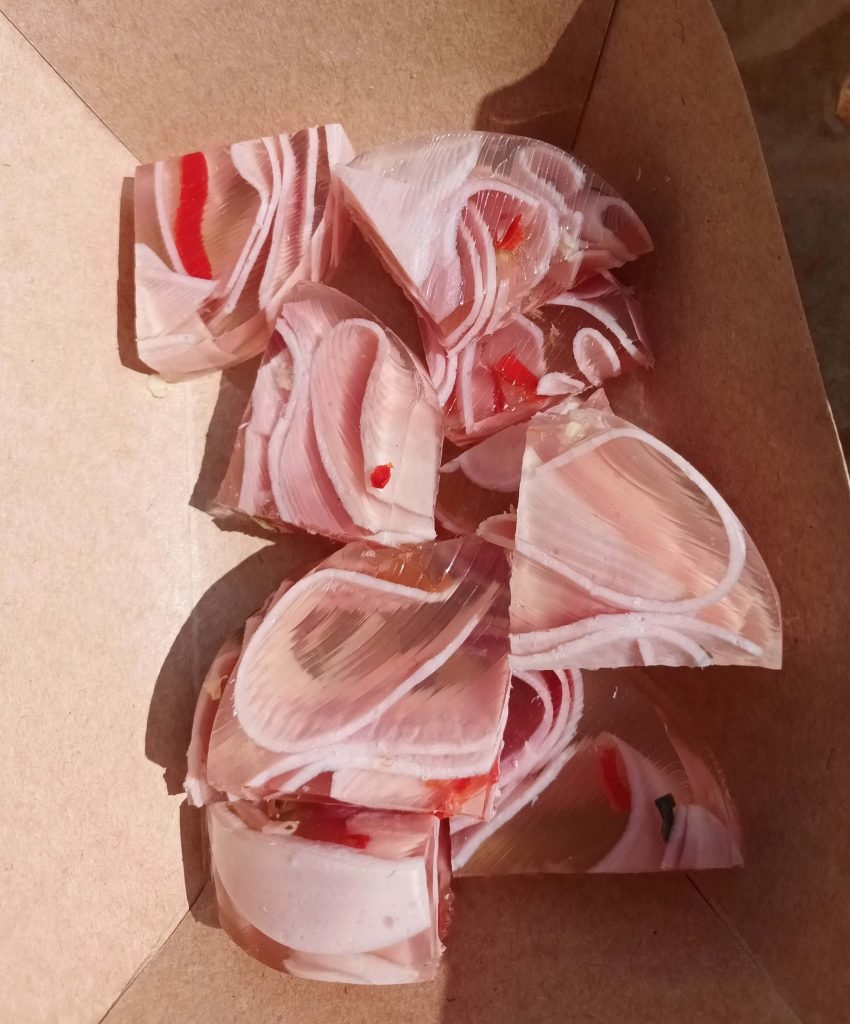

22. Mechový Dort
As soon as I heard about a cake shop in Brno famous for – wait for it – cake made from spinach, I knew I had to go.
It’s not that I’m a massive spinach fan.
I’m fairly neutral towards it on the whole.
However, the idea of a sweet cake made from spinach was so weird to me that I simply had to try and see what it was all about.
Mechový Dort, or Forest Moss Cake is a light spongy cake with a moist spinach-pistachio base, a homemade lemony cream cheese filling, and a thin layer of strawberry jam.
The cake is then decorated with pomegranate seeds, berries and real crickets to resemble a magical forest floor.
It may sound strange, but it tastes delicious and is extremely popular in both the Czech Republic and neighbouring Poland.
However, the origins of Forest Moss Cake, or ‘Spinach Cake,’ can actually be traced back to a Turkish cake named Ispanakli Kek.
Nevertheless, if you get a chance to try one while visiting Brno (or elsewhere in the Czech Republic), you won’t be disappointed!
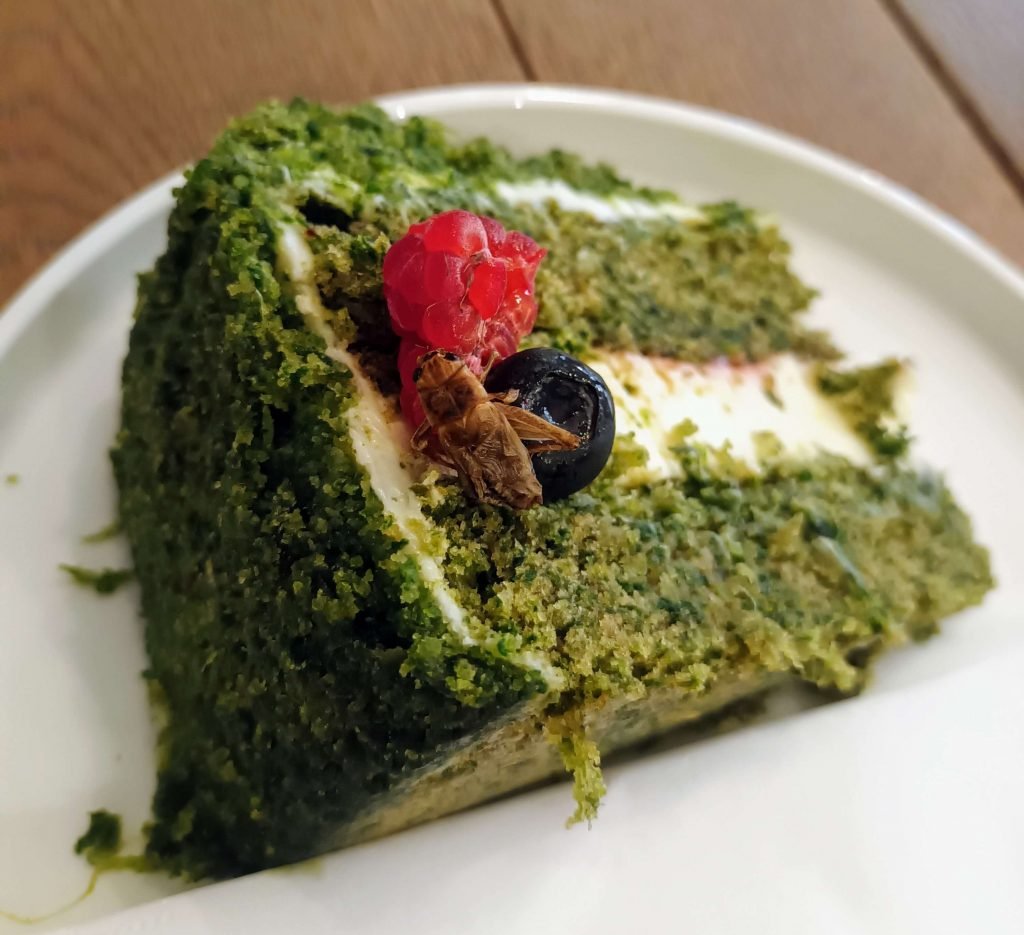
23. Koláče
Don’t be fooled by their light and fluffy appearance – Koláče cakes are stodgy.
Seriously, when I was handed one recently, I had to double check I wasn’t holding a calzone pizza rather!
These cakes are basically huge rings of sweet dough with a fruit filling in the middle (strawberries, apricots and prunes are popular), seasoned with nutmeg and mace and sprinkled with cheese.
My tip?
Order one of these from a bakery at breakfast time and you’ll be set up for the day.

24. Olomoucké Tvarůžky
Also affectionately known as ‘stinky cheese,’ Tvarůžky is native to the Czech Republic, specifically the city of Olomouc, in Central Moravia.
Since 2010 it has been registered as a Protected Geographical Indication by the European Union, and if you ever visit Moravia, you will find countless dishes featuring this cheese.
Made from a fat-free, sour curd, this cheese is also known as a ‘diet cheese,’ and it is also very high in protein.
Despite its nickname, Tvarůžky isn’t actually that stinky (anybody who disagrees has clearly never eaten blue cheese), and in its regular form, it has a texture unlike any other cheese I’ve tried.
Tvarůžky is most commonly eaten with bread and beer (or Slivovice), but you can also enjoy Tvarůžky soup (Hanácká Syrnica), Tvarůžky-stuffed potato pancakes, and even Tvarůžky ice cream!

25. Ovocné Knedlíky
And last, but by no means least on this list of traditional Czech foods, are Ovocné Knedlíky, sweet fruit dumplings.
Ovocné Knedlíky were another Czech food that I was lucky enough to see prepared in the cooking show, and trust me when I say that it takes serious elbow grease to make these babies!
The dumplings are folded around fruit (in our case blackberries) and cooked in boiling water.
We had them served with hot butter and cheese curds with a generous sprinkling of cinnamon and sugar, and they were divine.


Traditional Czech Food | Final Thoughts
So, that just about brings us to the end!
Of course, there are hundreds more traditional Czech dishes out there, but these are the main ones that you should try if you pay a visit to the Czech Republic.
Do bear in mind that Czech cuisine differs widely depending on which region you’re in (a few things on this menu are only popular in Moravia, for example), but you’ll be able to find the majority of these things around the whole country.
I hope that this was helpful, and now, the only thing left for me to say is DOBROU CHUŤ!
Until next time
XOXO
If you liked this article and would like to support my work, please click the button above to donate a couple of bucks and buy me a coffee. The ad revenue that I receive on this website is minimal, so support from my readers enables me to keep creating content that you (hopefully!) love to read.
*I am aware that the official name stated by the Czech government is Czechia, but most people still refer to the country as Czech Republic and from my research, I have found that both versions of the name seem to be correct. I am not trying to be political or invalidate the country in any way. Don’t come for me 😉

I absolutely loved your detailed exploration of traditional Czech dishes! Reading through this list brought back fond memories of my visit to Prague last winter, where I immersed myself in the local cuisine far beyond the typical tourist fare. I especially recall enjoying the hearty svíčková na smetaně; the creamy sauce paired with tender beef and those indispensable knedliky really felt like a warm embrace on chilly evenings. Your mention of Czech beer accompanying nearly every meal resonated with me too – it truly rounds out the culinary experience. I appreciate how you captured the blend of influences from neighboring regions, which adds layers to the flavors. This article has inspired me to try recreating some of these classic dishes at home and to share this rich culinary heritage with friends. Thank you for shedding light on such a comforting and somewhat underrated cuisine!